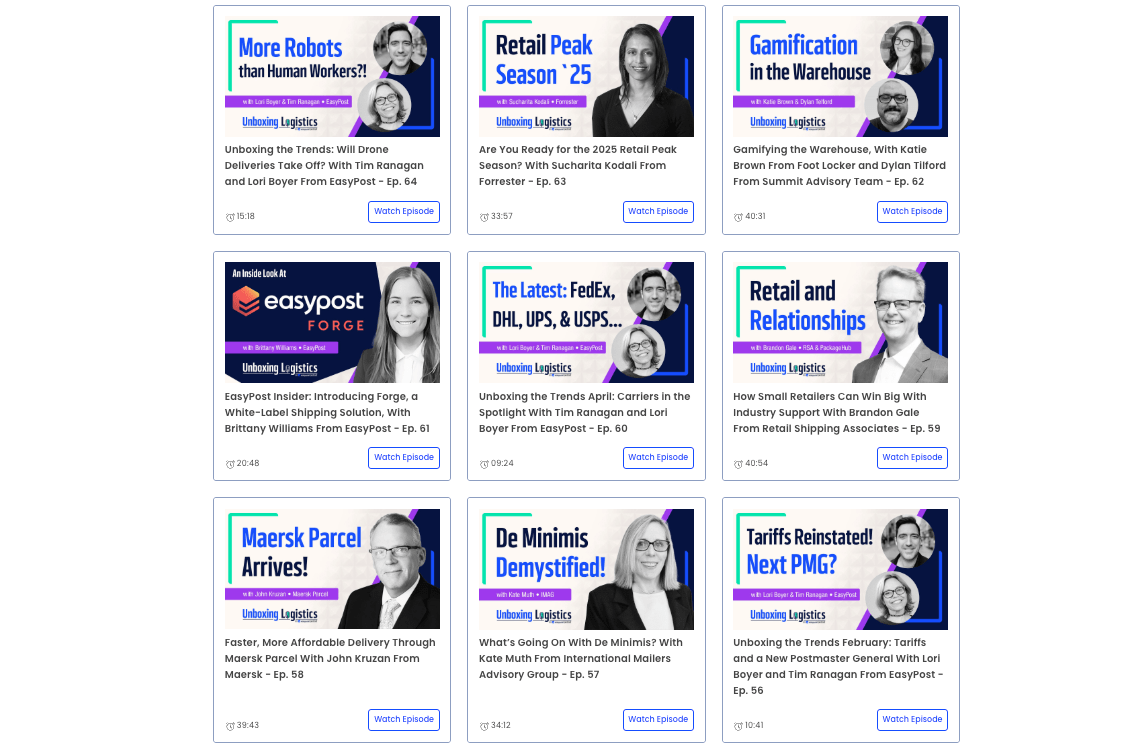
A Quick Recap of the Latest Unboxing Logistics Episodes
by Jaidyn Farar
The first half of 2025 has flown by! And as always, the world of logistics has been changing fast, with new regulations (and challenges) popping up left and right.
One of the best ways to stay informed? Listen to the Unboxing Logistics podcast. Whether you’re looking for ways to keep warehouse employees engaged, hoping to save on parcel shipping, or stocking up on peak season strategies, you’re sure to find something helpful.
Keep reading for a summary of our latest episodes.

Unboxing the Trends: Tariffs and a New Postmaster General w/ Lori Boyer and Tim Ranagan
In the second installment of the Unboxing the Trends series, Lori Boyer and Tim Ranagan from EasyPost dive into two major headlines shaking up the logistics world: new tariffs on key trading partners and a leadership change at USPS.
Lori and Tim discuss:
- Why new tariffs on Canada, Mexico, and China might not last
- How these tariffs could impact U.S. businesses
- What Postmaster General DeJoy’s resignation means for USPS
What’s Going On With De Minimis? w/ Kate Muth
With tariffs in the headlines, there’s also growing attention on the U.S. de minimis exemption—the rule that lets goods under $800 enter the country duty-free. Kate Muth, executive director of the International Mailers Advisory Group, explains what de minimis really is, why it matters, and what might happen if it changes.
Kate and Lori discuss:
- What the de minimis exemption is (and why it’s not a loophole)
- Why the U.S. paused a planned rollback of de minimis rules
- Why small businesses are most at risk from new import costs
Faster, More Affordable Delivery Through Maersk Parcel w/ John Kruzan
Best known for ocean freight, Maersk is now making waves in the parcel space.
In this episode, John Kruzan introduces Maersk Parcel—a regional pickup and delivery service designed for small and mid-sized businesses. With fast transit times, competitive rates, and simple setup, it might be just what your shipping mix is missing.
John and Lori discuss:
- Who Maersk Parcel is built for and where it operates
- Key benefits like sub-pound rates, fast delivery, and easy claims
- How to start shipping with Maersk Parcel through EasyPost
How Small Retailers Can Win Big With Industry Support w/ Brandon Gale
Small retailers face big challenges—but they don’t have to face them alone. In this episode, Brandon Gale, CEO of Retail Shipping Associates and Package Hub Business Centers, shares how RSA supports independent store owners with the training, tools, and community they need to thrive.
Brandon and Lori discuss:
- How listening to customers can fuel long-term growth
- The resources RSA offers to help owners work on their business
- Why peer-to-peer networking is just as valuable as formal training
Unboxing the Trends: Carriers in the Spotlight w/ Lori Boyer and Tim Ranagan
April’s Unboxing the Trends episode is all about carriers. With leadership transitions, service adjustments, and customs complications in the mix, now’s the time to review your shipping strategy.
Lori and Tim discuss:
- Why more shippers are moving away from FedEx and UPS
- DHL’s pause on cross-border B2C shipments over $800
- USPS transit delays and the upcoming leadership change
EasyPost Insider: Introducing Forge, a White-Label Shipping Solution w/ Brittany Williams
In this EasyPost Insider episode, Lori chats with Senior Product Manager Brittany Williams to unveil Forge, EasyPost’s new white-label shipping solution for 3PLs, marketplaces, tech platforms, and carriers.
From streamlined onboarding to advanced analytics, Forge helps businesses support complex customer networks without writing a single line of code.
Brittany and Lori discuss:
- What Forge is and who it’s built for
- How admin tools make managing subaccounts simple
- Why Forge’s analytics stand out in the industry
Gamifying the Warehouse w/ Katie Brown and Dylan Telford
Season 5 kicks off with a lively conversation about turning warehouse work into something a little more fun—and a lot more effective.
Katie Brown of Foot Locker and Dylan Telford of Summit Advisory Team join Lori Boyer to break down how gamification is helping warehouse teams stay motivated, productive, and engaged.
Katie, Dylan, and Lori discuss:
- Why gamification works best when tied to real goals and rewards
- The importance of clear metrics before introducing competition
- Simple ways to start gamifying your own warehouse
Are You Ready for the 2025 Retail Peak Season? w/ Sucharita Kodali
It’s officially time to start thinking about peak season.
In this episode, retail analyst Sucharita Kodali from Forrester joins Lori to break down what retailers should expect this year—from shifting consumer confidence to the impact of tariffs—and how to prepare without overextending your budget.
Sucharita and Lori discuss:
- Why peak season will likely bring heavy discounting
- What current spending trends say about consumer behavior
- Whether or not businesses should frontload inventory
Unboxing the Trends: Will Drone Deliveries Take Off? w/ Lori Boyer and Tim Ranagan
June’s Unboxing the Trends episode focuses on three big moves in shipping and logistics: warehouse automation, carrier shifts, and drone delivery. Lori and Tim unpack what these trends mean for businesses.
Lori and Tim discuss:
- Amazon’s million-robot warehouse milestone
- Changes in Amazon’s relationships with UPS and FedEx
- Walmart’s expansion of drone delivery in major cities—and the hurdles ahead
Season 5 is just getting started
Can you believe we’re already on Season 5 of Unboxing Logistics? In the two years since the podcast’s inception, Lori has interviewed well over 60 guests. That’s a lot of expert knowledge, and it’s all available on your favorite podcast streaming platforms.
Check out past episodes for answers to your most pressing logistics questions, and follow along to see what Season 5 holds in store—trust us, you won’t want to miss out.
Find new episodes here or subscribe on your favorite podcast platform. Unboxing Logistics is available on Spotify, YouTube, Apple Podcasts, Amazon Music, Pandora, and Audible.